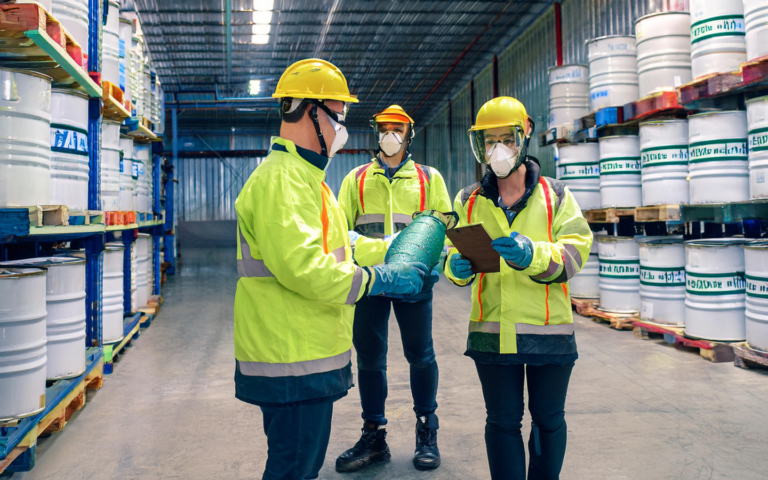
Safety in the Use of Personal Protective Equipment During Winter

Handling hazardous materials during the holiday season presents unique safety challenges across industries. With increased demand for transportation, construction, and environmental services, the risk of accidents involving hazardous substances escalates. The Occupational Safety and Health Administration (OSHA) underscores the importance of specialized protocols to address these heightened risks during peak periods (OSHA, 2019). This article explores why safety in the handling of hazardous materials is critical during the holidays and provides practical strategies for mitigating risks.
Importance Across Key Industries
Transportation Industry
The holiday season sees a surge in the movement of goods, including hazardous materials like flammable liquids, corrosive substances, and gases. The Department of Transportation (DOT) mandates specific safety measures, such as proper labeling, secure packaging, and specialized training for drivers transporting hazardous materials (DOT, 2020). Non-compliance not only endangers public safety but also results in significant financial penalties and delays.
Construction Industry
Construction activities involving hazardous chemicals, such as solvents, paints, and adhesives, often increase during the holidays due to year-end project deadlines. OSHA highlights that workers must have access to Safety Data Sheets (SDSs) and wear appropriate personal protective equipment (PPE) to minimize exposure risks (OSHA, 2019). Ensuring proper storage and disposal of hazardous materials is equally critical.
General Industry
Warehouses and manufacturing plants face unique challenges in handling hazardous materials during holiday peak production. The National Institute for Occupational Safety and Health (NIOSH) advises implementing stringent safety protocols, including spill response plans and employee training on chemical handling procedures (NIOSH, 2022).
Environmental Services
Environmental cleanup crews often deal with hazardous waste under harsh weather conditions during the holiday season. The Environmental Protection Agency (EPA) emphasizes the need for adequate PPE, spill containment equipment, and robust emergency response plans to handle hazardous materials safely (EPA, 2023).
Four Key Areas of Hazardous Material Safety
- Prevention
Implement risk assessments to identify potential hazards and ensure proper labeling and storage of all hazardous materials. Provide workers with comprehensive training on handling protocols (OSHA, 2019).
- Preparedness
Establish emergency response plans tailored to holiday operations, including protocols for chemical spills and fire outbreaks. Ensure the availability of spill kits and fire extinguishers at all handling sites (Ready.gov, 2023).
- Response
Equip teams with real-time monitoring systems to detect hazardous material leaks and implement evacuation procedures swiftly (National Weather Service, 2022).
- Recovery
Conduct thorough post-incident investigations to identify root causes and implement corrective actions. Update safety policies based on lessons learned (NIOSH, 2022).
Best Practices for Handling Hazardous Materials
- Ensure all hazardous materials are labeled and stored per regulatory guidelines.
- Conduct regular inspections of storage facilities and transport vehicles.
- Provide workers with appropriate PPE and training on handling hazardous materials.
- Maintain updated SDSs for all chemicals on-site.
- Establish clear communication channels for reporting safety concerns.
Key Safety LLC’s Expertise in Hazardous Material Safety
At Key Safety LLC, we provide comprehensive solutions to enhance safety during the handling of hazardous materials. Our services include:
- Development of customized safety protocols aligned with OSHA and EPA standards.
- Training programs for employees on hazardous material handling and emergency response.
- Audits and risk assessments to identify and mitigate safety gaps.
Partner with Key Safety LLC to ensure your operations are safe, compliant, and efficient during the holiday season. Visit our blog for more insights or subscribe to our newsletter for updates on industry best practices.
References
Environmental Protection Agency. (2023). Hazardous Waste. EPA. https://www.epa.gov/hw
National Institute for Occupational Safety and Health. (2022). NIOSH Pocket Guide to Chemical Hazards. CDC. https://www.cdc.gov/niosh/npg/default.html
Occupational Safety and Health Administration. (2019). Hazard Communication Standard. OSHA. https://www.osha.gov/hazcom
Ready.gov. (2023). Chemicals and Hazardous Materials Incidents. Ready.gov. https://www.ready.gov/hazmat
National Weather Service. (2022). Weather Safety for All Hazards. NOAA. https://www.weather.gov/safety/
U.S. Department of Transportation. (2020). Pipeline and Hazardous Materials Safety Administration (PHMSA): Hazardous Materials Regulations. DOT. https://www.phmsa.dot.gov/

